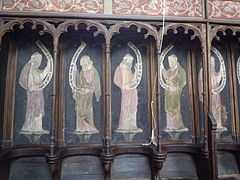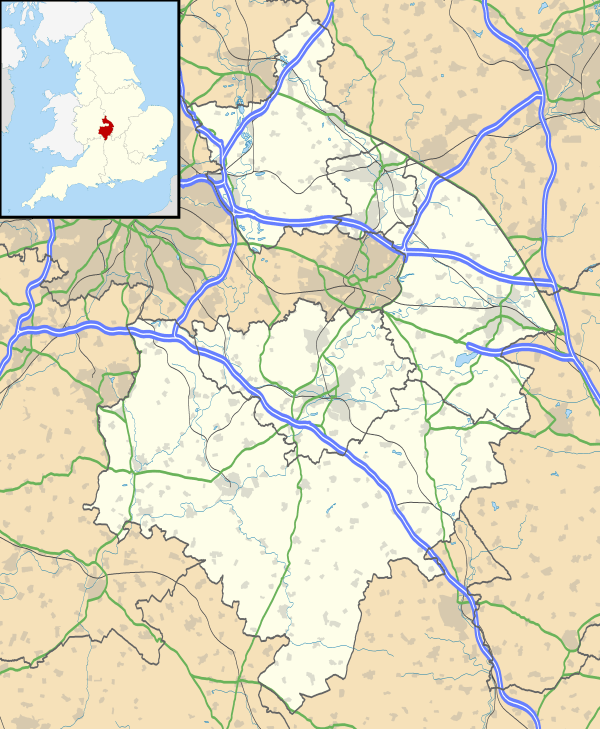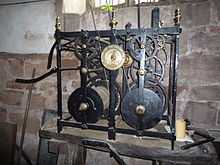Astley, Warwickshire
| Astley | |
 Painted stalls in the church of St Mary the Virgin |
|
 Astley |
|
| Population | 219 |
|---|---|
| OS grid reference | SP311894 |
| Civil parish | Astley |
| District | North Warwickshire |
| Shire county | Warwickshire |
| Region | West Midlands |
| Country | England |
| Sovereign state | United Kingdom |
| Post town | NUNEATON |
| Postcode district | CV10 |
| Police | Warwickshire |
| Fire | Warwickshire |
| Ambulance | West Midlands |
| EU Parliament | West Midlands |
|
|
Coordinates: 52°30′07″N 1°32′35″W / 52.502°N 1.543°W

Astley is a village and parish within the North Warwickshire district of Warwickshire, England.[1] In the 2001 census it had a population of 219.
Astley is Knebly in George Eliot's Mr Gilfil's Love Story. Eliot's parents were married in the church.[2]
St Mary the Virgin
The parish church was rebuilt by Sir Thomas Astley in 1343. An Anglo-Saxon carving of a sundial from an earlier church was preserved in the tower. Thomas Grey, 2nd Marquess of Dorset was entombed in the church in 1530. The present church dates from another rebuild in 1617 by the Chamberlayne family. It is mainly the chancel of the 1343 building and the original east window incorporated into the tower. Preserved in the church are effigies of the Grey family, eighteen choir stalls painted with images of the prophets and apostles and, on the ceiling, 21 heraldic shields of Midlands families.
Astley Castle
Astley Castle, a Grade II* listed building, is the last of three castles built on the same site and using the same moat. The castle was held by the Newdigate family in the 19th century, latterly being the home of Lieut-Gen. Edward Newdigate Newdegate. It was later a hotel, but is now a ruin following the fire in 1978.
The Landmark Trust is now spearheading a project to make the ruins safe, with the addition of modern style holiday homes within the actual ruins.
There is emerging evidence that Hitler may have planned to use Astley Castle if the Nazis had successfully invaded Britain during the Second World War. Astley Castle would have provided him with a fortified structure with appropriate security, supplemented by the protection of a moat. Astley would also have satisfied Hitler's desire for British countryside living with reasonable access to all the major cities.
References
- ↑ OS Explorer Map 232 : Nuneaton & Tamworth: (1:25 000) :ISBN 0 319 46404 0
- ↑ BBC - Exploring important George Eliot locations
External links
 Media related to Astley, Warwickshire at Wikimedia Commons
Media related to Astley, Warwickshire at Wikimedia Commons- Astley Castle at E Castles
- Astley Church website
- In the news at the Guardian website
- Photos of Astley, Warwickshire and surrounding area on geograph
- Astley in the Domesday Book